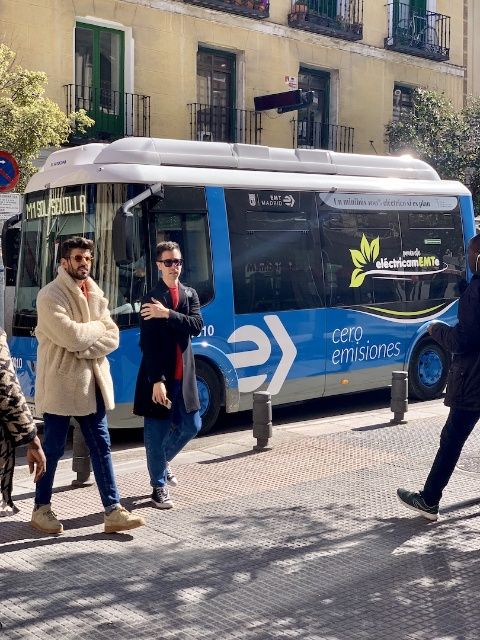目标检测 YOLOv5 - 推理时的数据增强
目标检测 YOLOv5 - 推理时的数据增强
flyfish
版本 YOLOv5 6.2
参考地址
https://github.com/ultralytics/yolov5/issues/303
在训练时可以使用数据增强,在推理阶段也可以使用数据增强
在测试使用数据增强有个名字叫做Test-Time Augmentation (TTA)
实际使用中使用了大中小三个不同分辨率,中间大小分辨率的图像进行了左右反转
大分辨率
480 * 640 宽度W 高度H 比例为1

中分辨率
416 * 544 宽度W 高度H 比例为0.83

小分辨率
352 * 448 宽度W 高度H 比例为0.67
命令
python detect.py --weights ./yolov5s.pt --source ./data/images/bus.jpg --imgsz 640 --augment
--augment语法
推理时默认不使用增强
import argparse
parser = argparse.ArgumentParser()
parser.add_argument("-v", "--verbose", help="increase output verbosity",
action="store_true")
args = parser.parse_args()
if args.verbose:
print("verbosity turned on")
else:
print("verbosity turned off")
假如上段代码是test.py
# python test.py
# 输出 verbosity turned off
# python test.py -v
# 输出 verbosity turned on
验证图像大小是每个维度上的stride的倍数,默认是32的倍数
例如 图像大小是1111 那么就是
--img-size [1111, 1111] 更新为 [1120, 1120]
def check_img_size(imgsz, s=32, floor=0):
# Verify image size is a multiple of stride s in each dimension
if isinstance(imgsz, int): # integer i.e. img_size=640
new_size = max(make_divisible(imgsz, int(s)), floor)
else: # list i.e. img_size=[640, 480]
imgsz = list(imgsz) # convert to list if tuple
new_size = [max(make_divisible(x, int(s)), floor) for x in imgsz]
if new_size != imgsz:
LOGGER.warning(f'WARNING: --img-size {imgsz} must be multiple of max stride {s}, updating to {new_size}')
return new_size
推理增强部分
def _forward_augment(self, x):
img_size = x.shape[-2:] # height, width
s = [1, 0.83, 0.67] # scales
f = [None, 3, None] # flips (2-ud, 3-lr)
y = [] # outputs
for si, fi in zip(s, f):
xi = scale_img(x.flip(fi) if fi else x, si, gs=int(self.stride.max()))
print("xi.shape[2:]:",xi.shape[2:])
yi = self._forward_once(xi)[0] # forward
print("0 yi:",yi.shape)
#cv2.imwrite(f'img_{si}.jpg', 255 * xi[0].cpu().numpy().transpose((1, 2, 0))[:, :, ::-1]) # save
yi = self._descale_pred(yi, fi, si, img_size)
print("1 yi.shape:",yi.shape)
y.append(yi)
y = self._clip_augmented(y) # clip augmented tails
return torch.cat(y, 1), None # augmented inference, train
def _descale_pred(self, p, flips, scale, img_size):
# de-scale predictions following augmented inference (inverse operation)
if self.inplace:
p[..., :4] /= scale # de-scale
if flips == 2:
p[..., 1] = img_size[0] - p[..., 1] # de-flip ud
elif flips == 3:
p[..., 0] = img_size[1] - p[..., 0] # de-flip lr
else:
x, y, wh = p[..., 0:1] / scale, p[..., 1:2] / scale, p[..., 2:4] / scale # de-scale
if flips == 2:
y = img_size[0] - y # de-flip ud
elif flips == 3:
x = img_size[1] - x # de-flip lr
p = torch.cat((x, y, wh, p[..., 4:]), -1)
return p
def _clip_augmented(self, y):
# Clip YOLOv5 augmented inference tails
nl = self.model[-1].nl # number of detection layers (P3-P5)
g = sum(4 ** x for x in range(nl)) # grid points
e = 1 # exclude layer count
i = (y[0].shape[1] // g) * sum(4 ** x for x in range(e)) # indices
y[0] = y[0][:, :-i] # large
i = (y[-1].shape[1] // g) * sum(4 ** (nl - 1 - x) for x in range(e)) # indices
y[-1] = y[-1][:, i:] # small
return y
关于翻转看
if self.inplace:
p[..., :4] /= scale # de-scale
if flips == 2:
p[..., 1] = img_size[0] - p[..., 1] # de-flip ud
elif flips == 3:
p[..., 0] = img_size[1] - p[..., 0] # de-flip lr
2表示上下翻转
3表示左右翻转
s = [1, 0.83, 0.67] 是缩放比例,且能被32整除
这里的顺序是HW
xi.shape[2:]: torch.Size([640, 480])
xi.shape[2:]: torch.Size([544, 416])
xi.shape[2:]: torch.Size([448, 352])
yi.shape: torch.Size([1, 18900, 85])
yi.shape: torch.Size([1, 13923, 85])
yi.shape: torch.Size([1, 9702, 85])
合并去冗余之后再进NMS
torch.Size([1, 34233, 85])
原来推理一张图像,增强后是推理3张
